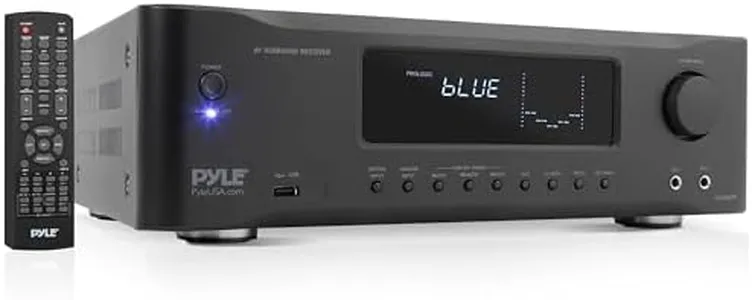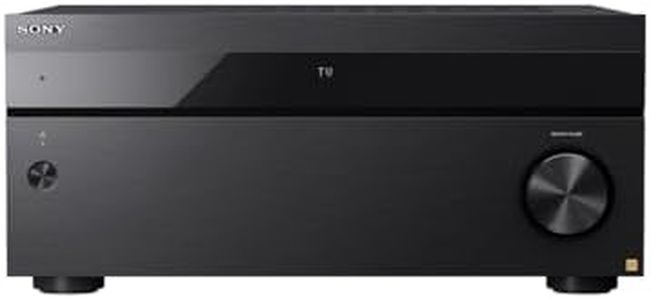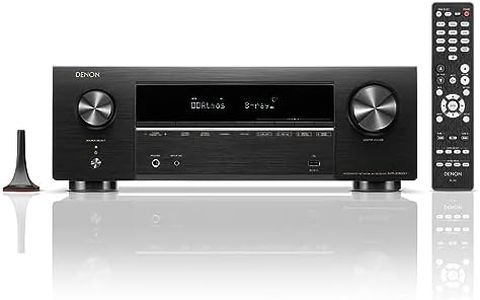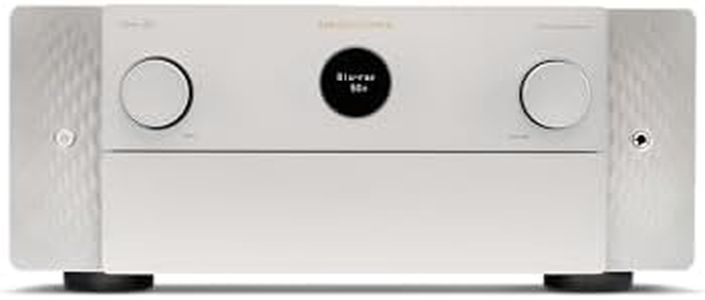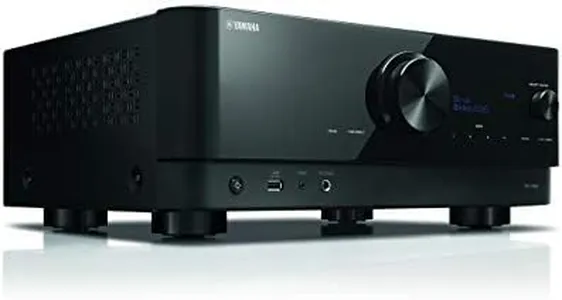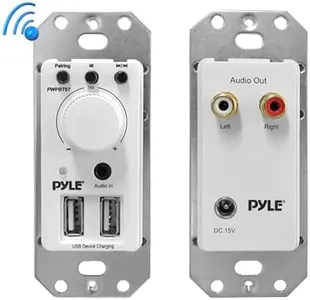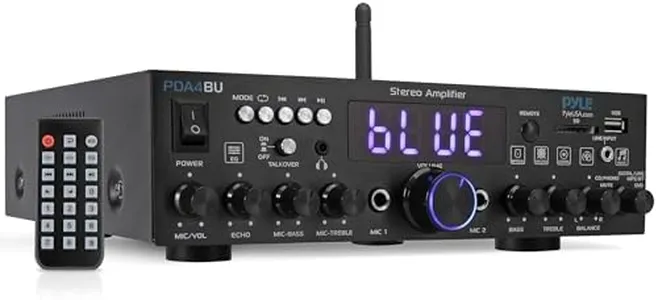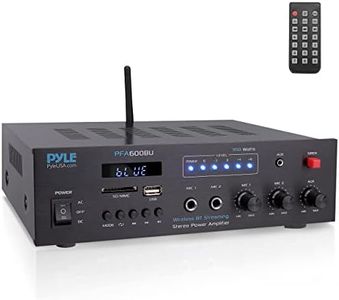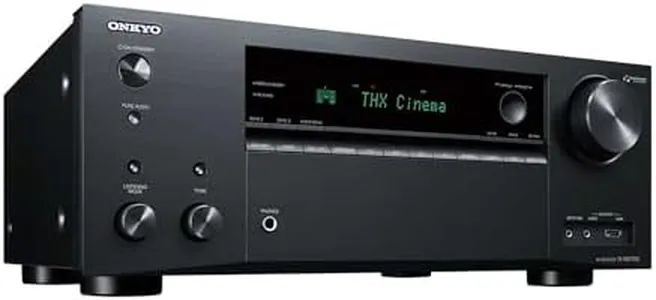10 Best Home Receiver Amplifiers 2025 in the United States
Our technology thoroughly searches through the online shopping world, reviewing hundreds of sites. We then process and analyze this information, updating in real-time to bring you the latest top-rated products. This way, you always get the best and most current options available.

Our Top Picks
Winner
Sony STRAZ3000ES Premium ES 9.2 CH 8K A/V Receiver
Most important from
74 reviews
The Sony STRAZ3000ES Premium ES 9.2 CH 8K A/V Receiver offers a powerful and versatile solution for home audio enthusiasts. With 120W per channel and support for 9.2 channels, it can deliver robust and immersive sound, making it suitable for large home theater setups. The inclusion of 8K and 4K/120 HDMI connectivity, along with 6 HDMI inputs and 2 outputs, ensures it can handle high-definition video from multiple sources easily. The receiver supports advanced audio formats like Dolby Atmos and DTS:X, providing a 3D audio experience for a truly immersive listening experience.
Additionally, its Digital Cinema Auto Calibration IX and 360 Spatial Sound Mapping help optimize sound quality based on your room's acoustics, which is a valuable feature for achieving the best audio performance in any space. The device also supports popular HDR formats such as Dolby Vision, HDR10, Hybrid Log Gamma, and IMAX Enhanced, ensuring excellent video quality. Integration with SONOS systems and compatibility with streaming services via Bluetooth, Wi-Fi, Chromecast, Spotify Connect, and Apple AirPlay add to its versatility.
Smart home enthusiasts will appreciate its compatibility with Google Assistant for voice control. On the downside, some users might find the setup process a bit complex, especially if they are not familiar with advanced audio equipment. Additionally, the total harmonic distortion (THD) at 0.9% is slightly higher than some high-end models, which might be noticeable to audiophiles. However, with its extensive connectivity options, powerful output, and support for the latest video and audio formats, the Sony STRAZ3000ES is an excellent choice for those looking to create a high-quality home entertainment system.
Most important from
74 reviews
Denon AVR-X1800H 7.2 Channel AV Stereo Receiver - 80W/Channel, Wireless Streaming via Built-in HEOS, WiFi, & Bluetooth, Supports Dolby Vision, HDR10+, Dynamic HDR, & Home Automation Systems
Most important from
1009 reviews
The Denon AVR-X1800H 7.2 Channel AV Receiver offers a solid power output of 80W per channel, making it suitable for small to medium-sized rooms. With 7.2 channels, it provides versatile audio configurations, including Dolby Atmos and DTS:X, for an immersive surround sound experience. The built-in HEOS technology allows for seamless wireless streaming and multi-room audio, making it a great option for modern home setups.
Connectivity options are robust, featuring Wi-Fi, Bluetooth, USB, and multiple HDMI inputs that support 8K video and HDR formats like Dolby Vision and HDR10+ for high-quality visuals. The device also supports voice control through Alexa, Siri, and other smart home systems, adding to its convenience. However, the unit's weight of 19 pounds and dimensions may require adequate space for installation.
In terms of performance, the receiver excels in delivering clear and dynamic sound with a low total harmonic distortion, ensuring high audio fidelity. The user-friendly setup guide and color-coded connections simplify installation and configuration. This receiver is ideal for users looking for a feature-rich, high-performance AV receiver with extensive connectivity and streaming options.
Most important from
1009 reviews
Marantz Cinema 40 9.4 Channel (125 Watt X 9) 8K UHD Home Theater AV Receiver with HEOS (Silver/Gold)
The Marantz Cinema 40 AV Receiver is a powerful and versatile home theater amplifier suited for those looking to enhance their audio experience. With an impressive 125 watts per channel across 9.4 channels, it provides robust sound output suitable for large spaces and immersive audio experiences. The 8K UHD capability ensures future-proof video compatibility, making it an excellent choice for high-definition enthusiasts.
Its surround sound configuration and 3D audio support enhance the cinematic experience, elevating your home theater setup significantly. Connectivity options include Bluetooth, USB, and HDMI, ensuring compatibility with smartphones, speakers, and other devices, and offering flexibility in how you connect your audio sources. The integration of HEOS allows for music streaming, and compatibility with Google Assistant and Amazon Alexa provides convenient voice control options. The receiver also features room calibration technology, which helps optimize audio performance based on your room's acoustics.
On the downside, at 39.6 pounds, it is quite heavy and may require a sturdy and spacious setup area. Additionally, the product’s rank in electronics is relatively low, which might indicate it’s less popular compared to other options. Despite these minor drawbacks, this AV receiver is ideal for those serious about home theater audio quality and willing to invest in a premium product to achieve top-notch sound experiences.
Buying Guide for the Best Home Receiver Amplifiers
Choosing the right home receiver amplifier can significantly enhance your home audio experience. A receiver amplifier is the heart of your home audio system, responsible for receiving audio signals, amplifying them, and sending them to your speakers. To make an informed decision, you need to understand the key specifications and how they align with your needs. Here are the essential specs to consider when selecting a home receiver amplifier.FAQ
Most Popular Categories Right Now
